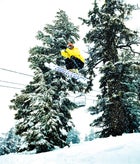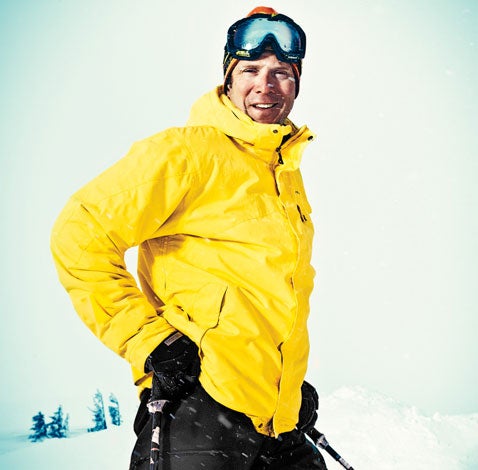DREW BLEDSOE bombs through six inches of fresh powder on Oregon’s Mount Bachelor, smoothly turns through a few trees, then rockets off a jump. He floats with perfect ski-porn technique—hands forward, knees balled to his chest—for 40 feet before touching down, making a few turns, and stopping to look back up the hill.
Bledsoe with daughter Healy
 Bledsoe with daughter Healy
Bledsoe with daughter HealyPlay action: Bledsoe airborne at Oregon's Mount Bachelor in April
 Play action: Bledsoe airborne at Oregon’s Mount Bachelor in April
Play action: Bledsoe airborne at Oregon’s Mount Bachelor in April“Well, that was fun,” he shouts toward where I’m standing. “I’m gonna hike up and do it again.”
Bad call. On his second attempt, Bledsoe loses control and slams his six-foot-five, 230-pound frame into the mountain. When the snow cloud settles, he’s smiling and brushing himself off.
“I’m fine,” he shouts. “Didn’t hurt at all.”
The man could always take a hit. During a 14-year career in the NFL, the quarterback led the New England Patriots to the Super Bowl in 1997. But to many, he’s best remembered for getting knocked senseless by Mo Lewis of the New York Jets in 2001. That tackle introduced the world to Bledsoe’s backup, Tom Brady, who never relinquished the job. Bledsoe went on to play for the Buffalo Bills and Dallas Cowboys before retiring in 2006.
Now, at 39, Bledsoe spends a large chunk of his time skiing, something he grew up doing in his home state of Washington and quietly continued throughout his career in the NFL.
“My second year in the league, I made the mistake of telling [Patriots owner] Bob Kraft that I’d taken my dad heli-skiing during the off-season,” Bledsoe says. “So the next time I go to sign a contract, it says I owe the team a bunch of money if I get hurt skiing. Didn’t stop me, though. I was able to take out an insurance policy with Lloyd’s of London that protected me for 20 ski days. That was some expensive skiing, but it was worth it.”
Now Bledsoe is channeling that passion into a business venture. Along with two partners from Whitefish, Montana, where he and his family spend summers, Bledsoe has formed the Montana Ski Company, a manufacturer of custom boards that will attempt to capitalize on the niche success of bespoke outfits like Wagner and Icelantic. Like those companies, Montana builds each pair of $600-to-$1,500 skis from scratch, adjusting everything from width under-foot to topsheet graphics to meet a client’s riding style and taste.
Turning a profit won’t be easy. The company is entering a crowded field: despite a weak economy, a dozen custom-ski manufacturers have started up in the past five years, taking advantage of cheaper manufacturing and the growth of online retail.
“Small companies can produce and market their skis without spending a lot of money,” says Pete Wagner, who founded Wagner Custom Skis in 2006. But the category, fueled both by wealthy weekenders and by discerning diehards, is small. Wagner, who sells his skis for $1,750, says it took him three and a half years to sell 2,500 pairs, enough to make the company profitable. By contrast, industry giant K2 sold 100,000 pairs in 2010 alone.
This year, Wagner expects to sell about a thousand pairs of skis, making his one of the most successful boutique brands out there. “But we’re the exception,” he says. “Most people doing this are garage tinkerers who build 50 or 100 pairs a year. A lot of those companies don’t last very long.”
“I’m surprised any of them survive,” says Reddy Kennedy, marketing manager at the trade group SnowSports Industries America. “Do the math: even if you’re selling 500 pairs of skis a year, it’s hard to imagine how you can cover your overhead.”
Montana Ski Company, in fact, sold only 100 pairs of skis its first season, though it’s tough to imagine Bledsoe bankrolling a flop. As an athlete-investor, he has enjoyed a track record that, while perhaps not as impressive as George Foreman’s, is certainly better than Lenny Dykstra’s. After retiring from the Cowboys in 2006, Bledsoe bought Eleven Roasters, a gourmet-coffee business, then made his money back when he sold it in 2007. In 2010, he launched Doubleback, a winery. The gem in his portfolio is Ozonix, a company that developed a way to sterilize the hydrofracturing fluid used in natural-gas exploration without chemicals; the outfit recently signed a $44 million contract with several extractors.
To garner similar results in the custom-ski business, Bledsoe’s team will focus on keeping costs low. Montana Ski Company doesn’t have its own facility; instead, Bledsoe and his partners, Chad Wold and Zak Anderson, rent space in a skateboard-ramp factory. “We have very little overhead,” says Bledsoe.
The three are also taking a run at the alpine-touring market, which grew 44 percent last season. To attract the light-and-fast crowd, Montana has put most of its design energy into building all-wood skis that make hiking easy without sacrificing performance.
At Bachelor, I try a pair of all-mountain Montanas. Since they’re manufactured entirely from wood (apart from their metal edges and plastic base), they’re incredibly damp and plow through chop and over uneven terrain without flopping around. They’re also lighter than the Völkls I normally hike with, something I notice as I shoulder them for a short hike out of bounds to one of Bledsoe’s favorite sidecountry spots. At lunch, though, I tell Bledsoe I wish they had a bit more sidecut.
“They can,” he says. “That’s the beauty of what we’re doing. We can customize them to have any turning radius you want. We can even put a picture of you on them.” Anderson, who’s in charge of ski design, is also willing to improve on models made by industry giants.
“If a guy comes in and says he’s skiing on, say, the Rossignol S7 but wishes it was a little stiffer or softer,” says Anderson, “we’ll build him a ski that’s designed like the S7, but we’ll use different combinations of wood to make it stiffer or softer.”
It’s a service Wagner offers, too. And though Wagner’s destined to lose a few sales to Montana, he sees Bledsoe’s entry into the market as a good thing. “People know his name,” says Wagner. “It should shine more light on the custom-ski industry as a whole.”
After finishing up on the mountain, Bledsoe and I drive to Cascade Lakes Brewing Lodge in Bend for beers and fish tacos. I start telling some of Bledsoe’s friends about his giant air when one of them stops me. “He’s just gonna get a big head about it,” he says.
“Nah, I just need to test the skis,” Bledsoe replies, “make sure they won’t break.” Testing is clearly the thing he enjoys most about launching his company.
“We’re not going to retire on the money we make, but we have fun with this,” he says, tipping back an IPA. “The skis are good.”
DREW BLEDSOE bombs through six inches of fresh -powder on Oregon’s Mount Bachelor, smoothly turns through a few trees, then -rockets off a jump. He floats with perfect ski-porn technique—hands forward, knees balled to his chest—for 40 feet before touching down, making
a few turns, and stopping to look back up the hill.
“Well, that was fun,” he shouts toward where I’m -standing. “I’m gonna hike up and do it again.”
Bad call. On his second -attempt, Bledsoe loses control and slams his six-foot-five, 230-pound frame into the mountain. When the snow cloud settles, he’s smiling and brushing himself off.
“I’m fine,” he shouts. “Didn’t hurt at all.”
The man could always take
a hit. During a 14-year career
in the NFL, the quarterback
led the New England Patriots
to the Super Bowl in 1997. But to many, he’s best remembered
for getting knocked senseless by Mo Lewis of the New York Jets in 2001. That tackle introduced the world to Bledsoe’s backup, Tom Brady, who never relinquished the job. Bledsoe went on to play for the Buffalo Bills and Dallas Cowboys before retiring in 2006.
Now, at 39, Bledsoe spends a large chunk of his time skiing, something he grew up doing in
his home state of Washington and quietly continued throughout his career in the NFL.
“My second year in the league, I made the mistake of telling [Patriots owner] Bob Kraft that I’d taken my dad heli-skiing during the off-season,” Bledsoe says. “So the next time I go to sign a contract, it says I owe the team a bunch of money if I get hurt skiing. Didn’t stop me, though. I was able to take out an -insurance policy with Lloyd’s of London that protected me for 20 ski days. That was some expensive skiing, but it was worth it.”
Now Bledsoe is channeling that passion into a business venture. Along with two partners from Whitefish, Montana, where he and his family spend summers, Bledsoe has formed the Montana Ski Company, a manufacturer of custom boards that will attempt to capitalize on the niche success of bespoke outfits like Wagner and Icelantic. Like those companies, Montana builds each pair of $600-to-$1,500 skis from scratch, adjusting everything from width under-foot to topsheet graphics to meet a -client’s riding style and taste.
Turning a profit won’t be easy. The com-pany is entering a crowded field: despite a weak economy, a dozen custom-ski manufacturers have started up in the past five years, taking advantage of cheaper manufacturing and the growth of online retail.
“Small companies can produce and market their skis without spending a lot of -money,” says Pete Wagner, who founded Wagner Custom Skis in 2006. But the category, fueled both by wealthy weekenders and by discerning diehards, is small. Wagner, who sells his skis for $1,750, says it took him three and a half years to sell 2,500 pairs, enough to make the company profitable. By contrast, industry giant K2 sold 100,000 pairs in 2010 alone.
This year, Wagner expects to sell about a thousand pairs of skis, making his one of the most suc-cessful boutique brands out there. “But we’re the exception,” he says. “Most people doing this are garage tinkerers who build 50 or 100 pairs a year. A lot of those companies don’t last very long.”
“I’m surprised any of them survive,” says Reddy Kennedy, marketing manager at the trade group SnowSports Industries America. “Do the math: even if you’re selling 500 pairs of skis a year, it’s hard to imagine how you can cover your overhead.”
Montana Ski Company, in fact, sold only 100 pairs of skis its first season, though it’s tough to imagine Bledsoe bankrolling a flop. As an athlete-investor, he has enjoyed a track record that, while perhaps not as impressive as George Foreman’s, is certainly better than Lenny Dykstra’s. After retiring from the Cowboys in 2006, Bledsoe bought Eleven Roasters, a gourmet-coffee business, then made his money back when he sold it in 2007. In 2010, he launched Doubleback, a winery. The gem in his portfolio is Ozonix, a company that developed a way to sterilize the hydrofracturing fluid used in natural-gas exploration without chemicals; the outfit recently signed a $44 million contract with several extractors.
To garner similar results in the custom-ski business, Bledsoe’s team will focus on keeping costs low. Montana Ski Company doesn’t have its own facility; instead, Bledsoe and his partners, Chad Wold and Zak Anderson, rent space in a skateboard-ramp factory. “We have very little overhead,” says Bledsoe.
The three are also taking a run at the -alpine- touring market, which grew 44 percent last season. To attract the light-and-fast crowd, Montana has put most of its design energy into building all-wood skis that make hiking easy without sacrificing performance.
At Bachelor, I try a pair of all-mountain Montanas. Since they’re manufactured -entirely from wood (apart from their metal edges and plastic base), they’re incredibly damp and plow through chop and over uneven terrain without flopping around. They’re also lighter than the Völkls I -normally hike with, something I notice as I shoulder them for a short hike out of bounds to one of Bledsoe’s favorite sidecountry spots. At lunch, though, I tell Bledsoe I wish they had a bit more sidecut.
“They can,” he says. “That’s the beauty of what we’re doing. We can customize them to have any turning radius you want. We can even put a picture of you on them.” Anderson, who’s in charge of ski design, is also willing to improve on models made by industry giants.
“If a guy comes in and says he’s skiing on, say, the Rossignol S7 but wishes it was a little stiffer or softer,” says Anderson, “we’ll build him a ski that’s designed like the S7, but we’ll use different combinations of wood to make it stiffer or softer.”
It’s a service Wagner offers, too. And though Wagner’s destined to lose a few sales to Montana, he sees Bledsoe’s entry into the market as a good thing. “People know his name,” says Wagner. “It should shine more light on the custom-ski industry as a whole.”
After finishing up on the mountain, Bledsoe and I drive to Cascade Lakes Brewing Lodge in Bend for beers and fish tacos. I start telling some of Bledsoe’s friends about his giant air when one of them stops me. “He’s just gonna get a big head about it,” he says.
“Nah, I just need to test the skis,” Bledsoe replies, “make sure they won’t break.” Testing is clearly the thing he enjoys most about launching his company.
“WE’RE NOT GOING TO RETIRE ON THE MONEY WE MAKE, BUT WE HAVE FUN WITH THIS,” HE SAYS, TIPPING BACK AN IPA. “THE SKIS ARE GOOD.”


